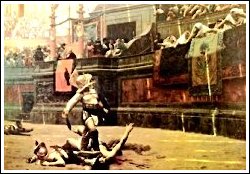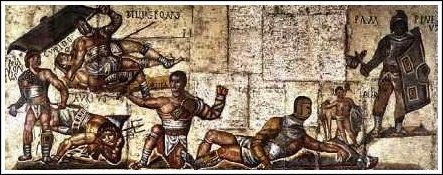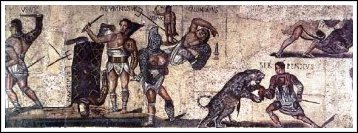- HubPages»
- Education and Science»
- History & Archaeology»
- Ancient History
Origins of the Gladiator



The origins of the gladiator come from sacrificial rites practiced by the Etruscans. The Etruscans were originally descended from bronze-age people around 700 BC called the Villanovans. They were a people who were deeply influenced by the Greeks and Phoenicians and lived mainly in northern Italy.
Gladiators were first brought to Rome around 264 BC. In the beginning it was part of a religious ceremony intended to insure the deceased would be accompanied to the "next world" by an armed escort and to appease spirits of the dead. The era of the gladiator lasted for around 700 years.
Historians have often pondered over Romans’ fascination with extreme violence. Perhaps it will always remain a mystery as to why a civilized country, making so many important contributions to the world could indulge in such barbaric exhibitions.



However, Roman gladiators eventually became men that fought to the death in ancient Rome mainly for the entertainment of the masses. Sometimes they would battle in ships on manmade lakes. At other times they would be pitted against wild animals such as tigers, bulls, lions, bears or even elephants.
There were five basic classifications of gladiators:
· Secutor- also known as the chaser. Chased opponent. One arm covered with leather or metal bands and used a short sword or dagger. Carried a shield, wore a leg guard called an ocrea.
· Retiarius- Used a three pointed spear called a trident and a net. He had no armor except for a headband and a guard on one arm with a flat shoulder piece.
· Hoplomachus-Heavily armored gladiator who used a short sword heavy shield and helmet with complete face guard.
· Mirmillo-also called the fish man and was identified by images of scales on helmet. Used a short sword and a big, round shield.


There were however, other even more exotic classifications. For example:
· The Essedarius, who fought from chariots.
· The Equites, who fought from horseback.
· The laquearii, who used a noose or lasso.
· The Velites who hurled missiles.
· The Sagittarius, who fought with bow and arrow.
· The Dimachaerus who wielded two swords.
The gladiator games were not an everyday occurrence. They were events scheduled for special occasions such as the Saturnalia festival honoring the god Saturn and was held for ten to twelve days each year.
Successful gladiators could become extremely rich and famous and in some cases win their freedom. Although, most gladiators were condemned criminals, slaves, prisoners of war or discharged soldiers, some were freemen who volunteered as a way to achieve fame and fortune. Those who went this route, however, usually took upon the status of a slave for an agreed-upon period of time, similar to that of indentured servitude.
Gladiators were named after the Roman sword called the gladius. At one time they made up half of all combatants and were trained at special schools. Many were retained privately by the socially elite as bodyguards.
There were even female gladiators. However, they were not generally paired to battle with men. They were usually pitted against other women or amusingly, with dwarfs. In any case, great pains were taken to make battles evenly matched. But, not identically matched. It was common practice to mix and match fighters from all five classifications.
Although the blood sport was extremely popular, it led to the near extinction of entire animal species. And most battles were fought to the death unless a life was spared by the audience. Unfortunately, this rarely happened.
During this age of superstitions gladiators were objects of morbid fascination by ancient Romans. Their blood was considered a remedy against impotence. Although they lived short, brutal lives, gladiators often were admired for their bravery. Their images have been found in mosaics, lamps and even funerary monuments. Gladiators themselves would sometimes write graffiti on these objects boasting about their skills and physical prowess.
The Roman spectators admired courage and discipline in gladiators. Those who refused to fight brought dishonor upon themselves and in the eyes of the Romans, their society as well. There was little sympathy for gladiators who displayed fear or cowardice.
For the fortunate few champions who managed to survive to a relative older age, many were given their freedom. They often established their own training schools.











